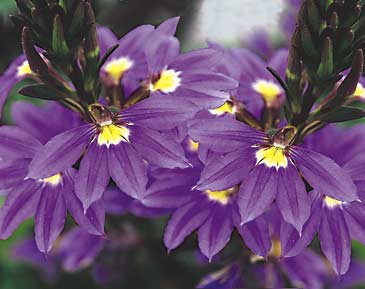 www.provenwinners.com
www.provenwinners.com
‘New Wonder’
by George Papadelis
I can remember a time when commercial growers of annuals had a relatively small list of plants from which to choose. We would order our seeds and then receive rooted cuttings of geraniums, vinca vines, fuchsias, and Rieger begonias. Then came New Guinea impatiens. These quickly became popular and gave us another major crop to produce. But several new annuals have come along that have completely changed the way we garden. Bacopa, verbena, calibrachoa, double flowering impatiens, wishbone flower (Torenia), dahlias, and petunias—all grown from cuttings—have exploded into the marketplace and continue to grow in popularity. Fan flower, or Scaevola, is another wonderful trailing or spreading plant with many uses for the modern landscape.
Scaevola is an enormous genus that contains plants native to Florida, Hawaii, Australia, and many other tropical environments. Some of these are invasive weeds, but the Australian species aemula is the ornamental blue-flowering plant from which most garden-worthy cultivars are derived. Scaevola gets its common name, fan flower, from the arrangement of its petals in a fan-shaped cluster. These form flowers that are arranged in bigger clusters 2 to 3 inches across. The flowers develop on trailing plants and last for several weeks.
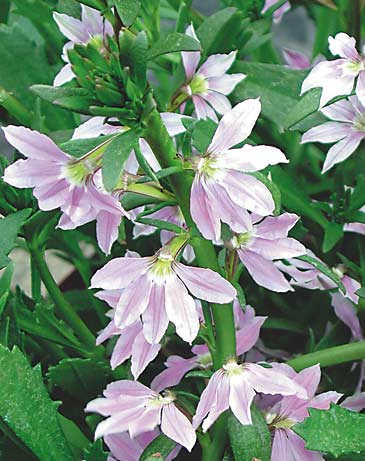 www.provenwinners.com
www.provenwinners.com
‘Pink Fanfare’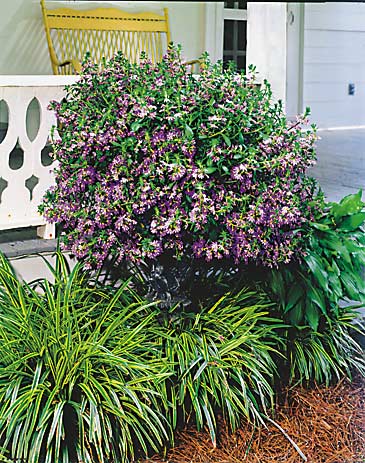 www.parkseed.com
www.parkseed.com
‘Purple Fan’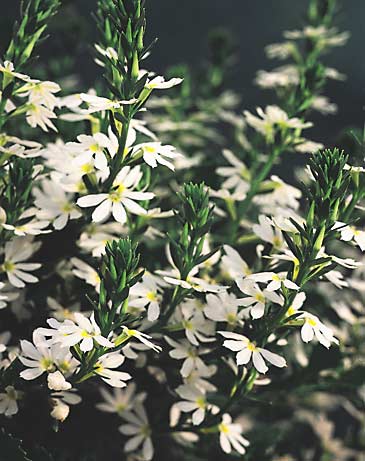 www.provenwinners.com
www.provenwinners.com
‘Whirlwind White’This long-lasting bloom time keeps deadheading to a minimum and makes fan flower a low maintenance plant. It is typically used in hanging baskets or as a trailing component in combination planters where it may grow 3 to 4 feet long. In addition, fan flower is also a wonderful spreading plant for beds. A single plant can spread to form a mound two or more feet across and about 8 to 12 inches tall.
One of the first fan flowers developed was ‘Blue Wonder.’ It is still very popular and has been joined by several similar blue cultivars like ‘New Wonder,’ ‘Whirlwind Blue,’ and ‘Blue Shamrock.’ These make excellent hanging basket plants by themselves or when combined with complimentary plants. Since each of these has blue petals with a yellow base, try combining them with yellow plants like bidens, Cape daisy (Osteospermum ‘Symphony Yellow’), marguerite daisy (Argyranthemum ‘Butterfly’), or Dahlberg daisy.
‘Zig Zag’ has big, beautiful flowers that are prominently bicolored violet and white. This cultivar blooms several weeks later than others. There are two popular white varieties, ‘White Charm’ and ‘Whirlwind White’ that are also great performers. ‘White Charm’ forms a more compact 12- by 12-inch mound while the latter can grow up to 24 inches wide. These also have yellow-based petals that look great with other yellow plants.
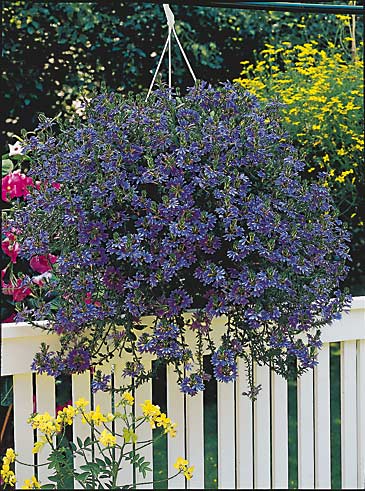 www.parkseed.com
www.parkseed.com
‘Blue Wonder’‘Pink Fanfare’ is one of the few pink cultivars. Its flowers are actually more of a muted lavender color. Plant breeders are working on some new colors and a good yellow variety will likely be introduced.
New plants like fan flower are great additions to the annual palette. Take a bold approach and try some of the new plants that breeders have been working hard to produce. If you have yet to try a fan flower, you and your garden will be very pleased with its performance. Try one in a combination planter, or better yet, drop one into a flowerbed. Maybe you’ll show a fellow gardener how to use a new plant.
George Papadelis is the owner of Telly’s Greenhouse in Troy, MI.
At a glance: Fan Flower
Botanical name: Scaevola aemula (skay-VO-lah EYE-mew-lah)
Plant type: Annual
Plant size: 8 to 24 inches tall and wide, depending on the variety
Habit: Spreading, trailing
Flower color: Violet, purple, white, light pink
Flower size: 2- to 3-inch clusters
Bloom period: Summer
Light: Sun
Soil: Well-drained
Uses: Containers, hanging baskets
Companion plants: Yellow-flowered annuals such as Bidens, Cape daisy (Osteospermum ‘Symphony Yellow’), marguerite daisy (Argyranthemum ‘Butterfly’), or Dahlberg daisy.
Remarks: Also can be planted in the ground to form spreading mound. Fan flower is a tender perennial that is treated as an annual.
